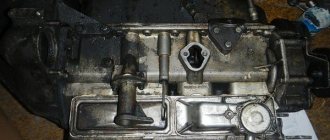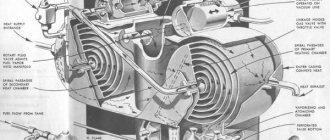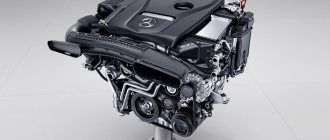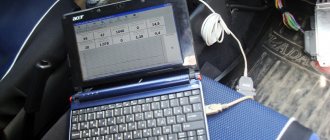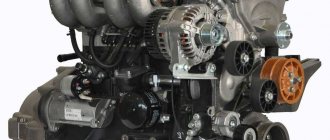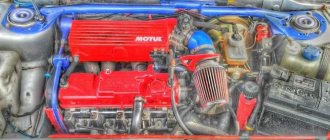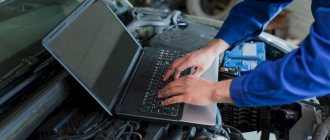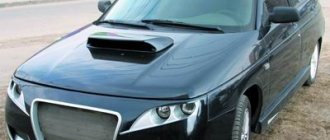The first day. Start of assembly
So, the parts are laid out on racks in the assembly shop. Morning coffee and a planning meeting woke everyone up. Having outlined the scope of work, I sent everyone to work areas. 40 minutes later the phone rang with the alarmed voice of the master, who was almost crying. Since I was in the city, I told him to calm down and that I would come soon. I didn’t travel, I flew from Mezhdunarodnaya metro station to the base. Of course, traffic jams on the bridge delayed us a bit.
Arriving at the base, I walked up to the workshop. There was no end to my horror. One of the cartridges fell apart. Since the whole process was filmed, I watched the footage again and again. There was no master error. I wrote a letter to the supplier of sleeve kits who sold them to me, and attached a detailed video of the process. If it weren't for the shooting, we would have lost money.
The supplier kindly, while apologizing ten times, agreed to send a new one if we sent the old one. The sleeve arrived two days later, but we already had enough work to do.
The installation of the crankshaft went without any particular nuances or problems, which even surprised and amused us. An engine turned upside down, where a shaft with main liners, which are pre-lubricated with oil, rests on the main yokes.
I completely forgot to say! We bought TOTAL 10w-40 semi-synthetic oil.
Then, the piston is connected to the connecting rod by pressing the pin. And in this operation, everything went perfectly. Using special pliers, piston rings are installed, of which there are 3 pieces each. for each cylinder.
Pistons with connecting rods are inserted into liners. In this case, the lower cover is removed from the connecting rod to secure it to the crankshaft. This operation was successful. Connecting rod bearings are installed on the connecting rod journals.
Malfunctions and repairs of the Volga/Gazelle ZMZ-402 engine
The ZMZ-402 engine is one of the most famous and popular engines from the Volga region, it is an aluminum block, with wet cast iron liners, with a lower camshaft, a valve driven by rods and rocker arms, in fact, it is a slightly modified ZMZ 24D, in which they changed exhaust manifold, cylinder head studs, a camshaft with a lift of 9.5 was installed instead of 9 mm, the head itself was slightly adjusted, the oil pump was changed, and other, less significant things were also changed. The ZMZ-402 engine is the highest point of development of the GAZ 21 engine, the same engine designed in the 50s...
Modifications of the ZMZ 402 engine:
1. ZMZ 402.10 - the main and most common engine, SZh 8.2, uses 92 gasoline. Used on Volga 2. ZMZ 4021.10 - engine with reduced coolant to 6.7, for 76 gasoline. Used on Volga 3. ZMZ 4022.10 - engine with prechamber-torch ignition. This type of engine was distinguished by a different cylinder head, intake, exhaust, a different camshaft, a modified carburetor and, in general, a more complex design. All these innovations were supposed to improve technical characteristics, efficiency, toxicity, etc. The result was a structurally complex motor, the efficiency was not so noticeable and further work was required to improve it, so in 1992, the production of prechamber engines was curtailed. 4. ZMZ 4025.10 - an analogue of ZMZ 4021.10, but for cars of the Gazelle family. 5. ZMZ 4026.10 - an analogue of ZMZ 402.10, but for cars of the Gazelle family.
Malfunctions of ZMZ 402 engines
1. The most famous weak point of the 402 engine is the rear crankshaft oil seal, which is nothing more than a rope soaked in graphite lubricant, it holds up to 2500 rpm, after exceeding this threshold, its properties are lost and it begins to drive oil out. Replacing the stuffing box with ZMZ 402 solves all the issues. 2. The design from the carburetor to the head is also crooked, so at idle the mixture is not supplied to the cylinders quite evenly, hence the ZMZ-402 has various twitches, vibrations and other delights of life at idle. 3. Knock of the ZMZ-402 engine, usually unadjusted valves are to blame for this, work to adjust the valve clearances must be carried out every 15,000 km, some owners install hydraulic compensators on the ZMZ 402 and the issue is partially resolved. If the valves are normal, then the knocking is caused by the camshaft or connecting rod bearings. 4. Vibration of the ZMZ 402. Usually it is provoked by the airbags, but if the supports are normal, then the problem is an imbalance in the crankshaft, carburetor or ignition system. 5. Engine overheating. For ZMZ-402 this phenomenon is normal, the problem is in the thermostat, pump or air lock in the cooling system. In principle, the design of the cooling system of the 402 engine is such that the central part of the cylinder head heats up more and over time the washers are pressed in and the nuts are loosened; if they are not tightened in a timely manner, you will experience burnout of the gasket.
The above malfunctions, of course, are not all, these are the most basic and most common problems, the list can go on forever, but the owner of a car with a ZMZ-402 engine must clearly understand that he is the owner of a retro engine and needs to be prepared for any of its whims. The ZMZ 402 engine also has its advantages: simplicity, survivability and maintainability; getting spare parts for the Volga/Gazelle is not a problem at any time of the day or night, anywhere in the CIS. A decent resource, if you take care of the engine, move carefully and do not twist it without reason, it will last from 200 thousand km or more. In general, by the standards of the 60-70s, the engine is good, but time passes, everything develops, improves, and by the standards of the 21st century, its place is in the museum, where it was sent in 2006. The 402 engine has many copies, these are engines produced by UMZ 451, 414, 417, 421, some of them are still produced to this day, all of these engines had one common ancestor - GAZ 21 and the design is almost identical. In 1997, ZMZ developed a successor to the 402 - ZMZ-406, we read about this 16 valve engine here.
Second day. Head and small parts assembly
Now, it was necessary to install the oil pump, pan, filter, assemble all the small parts and install the cylinder head. Let's start in order.
The oil pump was installed easily, as was the filter, which simply fit into the housing (in the form of a glass) and screwed on top with a lid. Standard system on 402 or 53 engines. We installed the thermostat, replaced the pump, and collected all the little things into a heap.
We decided to install the block head and pan. It turned out that the pan gasket was not suitable, since it was UAZ. I told the guys to cut it out of cork-rubber material. That seems to be all there is to it.
The cylinder head gasket was lubricated with graphite lubricant to maintain integrity and better adhesion of the parts. We decided to screw in the cylinder head studs that secure it to the block after we installed the head. We installed it, started screwing it in, and it turned out that the channels on the cylinder head were a little further diagonally, and were not living on the block. The solution was simple, drill them out a little. This operation was entrusted to our experienced milling machine operator. After this, another problem appeared - chips. It had to be cleaned by hand, since to wash it the head would have to be completely disassembled, and I didn’t want to do that.
When everything was ready, we, together, installed and secured the cylinder head. Everything seemed to be perfect. But doubts still crept in. The valve cover was placed on the head. It was decided to install the engine on the car and carry out the final assembly there.
I forgot to say again. Before installing the crankshaft, I bought a Sachs clutch for 2,200 rubles. and this entire structure was balanced on a stand. Important! This procedure is done to balance the shaft speed and adjust the clutch to its weight, which will give maximum efficiency to its use.
Malfunctions and repairs of the Volga/Gazelle ZMZ-402 engine
The ZMZ-402 engine is one of the most famous and popular engines from the Volga region, it is an aluminum block, with wet cast iron liners, with a lower camshaft, a valve driven by rods and rocker arms, in fact, it is a slightly modified ZMZ 24D, in which they changed exhaust manifold, cylinder head studs, a camshaft with a lift of 9.5 was installed instead of 9 mm, the head itself was slightly adjusted, the oil pump was changed, and other, less significant things were also changed. The ZMZ-402 engine is the highest point of development of the GAZ 21 engine, the same engine designed in the 50s...
Modifications of the ZMZ 402 engine:
1. ZMZ 402.10 - the main and most common engine, SZh 8.2, uses 92 gasoline. Used on Volga 2. ZMZ 4021.10 - engine with reduced coolant to 6.7, for 76 gasoline. Used on Volga 3. ZMZ 4022.10 - engine with prechamber-torch ignition. This type of engine was distinguished by a different cylinder head, intake, exhaust, a different camshaft, a modified carburetor and, in general, a more complex design. All these innovations were supposed to improve technical characteristics, efficiency, toxicity, etc. The result was a structurally complex motor, the efficiency was not so noticeable and further work was required to improve it, so in 1992, the production of prechamber engines was curtailed. 4. ZMZ 4025.10 - an analogue of ZMZ 4021.10, but for cars of the Gazelle family. 5. ZMZ 4026.10 - an analogue of ZMZ 402.10, but for cars of the Gazelle family.
Malfunctions of ZMZ 402 engines
1. The most famous weak point of the 402 engine is the rear crankshaft oil seal, which is nothing more than a rope soaked in graphite lubricant, it holds up to 2500 rpm, after exceeding this threshold, its properties are lost and it begins to drive oil out. Replacing the stuffing box with ZMZ 402 solves all the issues. 2. The design from the carburetor to the head is also crooked, so at idle the mixture is not supplied to the cylinders quite evenly, hence the ZMZ-402 has various twitches, vibrations and other delights of life at idle. 3. Knock of the ZMZ-402 engine, usually unadjusted valves are to blame for this, work to adjust the valve clearances must be carried out every 15,000 km, some owners install hydraulic compensators on the ZMZ 402 and the issue is partially resolved. If the valves are normal, then the knocking is caused by the camshaft or connecting rod bearings. 4. Vibration of the ZMZ 402. Usually it is provoked by the airbags, but if the supports are normal, then the problem is an imbalance in the crankshaft, carburetor or ignition system. 5. Engine overheating. For ZMZ-402 this phenomenon is normal, the problem is in the thermostat, pump or air lock in the cooling system. In principle, the design of the cooling system of the 402 engine is such that the central part of the cylinder head heats up more and over time the washers are pressed in and the nuts are loosened; if they are not tightened in a timely manner, you will experience burnout of the gasket.
The above malfunctions, of course, are not all, these are the most basic and most common problems, the list can go on forever, but the owner of a car with a ZMZ-402 engine must clearly understand that he is the owner of a retro engine and needs to be prepared for any of its whims. The ZMZ 402 engine also has its advantages: simplicity, survivability and maintainability; getting spare parts for the Volga/Gazelle is not a problem at any time of the day or night, anywhere in the CIS. A decent resource, if you take care of the engine, move carefully and do not twist it without reason, it will last from 200 thousand km or more. In general, by the standards of the 60-70s, the engine is good, but time passes, everything develops, improves, and by the standards of the 21st century, its place is in the museum, where it was sent in 2006. The 402 engine has many copies, these are engines produced by UMZ 451, 414, 417, 421, some of them are still produced to this day, all of these engines had one common ancestor - GAZ 21 and the design is almost identical. In 1997, ZMZ developed a successor to the 402 - ZMZ-406, we read about this 16 valve engine here.
Day three. Tests, installation on a car, problems
Since everything was prepared, we decided to install the manifolds and carburetor. Everything went as planned and so far there were no problems. Before installing the carburetor, we played around with it, replacing the jets and re-boring them a little. An ignition was also installed, without which starting is impossible. Well, with God!
So, the engine is installed on the test stand. Everything is connected and ready. A trembling hand presses the start button, and lo and behold, it starts. They let me work a little. Everything is fine, good sound, nothing rattles or knocks and so far no problems.
The engine was mounted on new mounts and connected to a new 5-speed manual transmission. Now it's time to connect everything else, and again the problem. The cooling system pipes are not suitable. We thought and wondered for a long time, but it was decided to buy Zhiguli and Volgov, several types and sculpt. And then we notice that the radiator is unusable. I, taking courage in my hands, buy a tuned massive one from Deco, for 6,000 rubles. It became perfect, and therefore the fasteners remained untouched.
Another problem was the air filter, which had to be replaced. A "zero" made by Phoenix was installed.
Everything was connected, and we decided to test the car first at idle, and then on the road. Of course, the feeling is unforgettable. The engine works in a new way, barely touching the gas pedal, it pulls power out from under itself. Approximately, it had up to 200 hp. True, we had to tinker with the ignition system, but our electrician set everything up.
What can be done
- You need to find the bottom camshaft numbered No. 2. It significantly increases the engine speed.
Low camshaft No. 2
- Expand the intake manifold to increase fuel supply. Also modify the channels so that there is a minimum number of transitions from the carburetor to the cylinder head.
- Grind the cylinder head and reduce it by 3.6 mm.
- Install rods 54-1007175, provided that grinding was done.
- Install poly V-pulleys and belt. It is recommended to take from the ZMZ 406 engine.
- Replace the piston using the “special purpose Kostroma piston” group.
- If possible, grind the connecting rods.
- Reduce the weight of the crankshaft counterweights. A threaded groove on the shaft is also necessary to prevent engine oil leakage.
- Install a lightweight flywheel or modify the old one.
- Install a new carburetor (for example 4178 DAAZ).
- Modify the exhaust system by installing a resonator in it.
- Completely replace the ignition system with a newer one, for example, Ladovskaya.
How exactly the power of the 402 engine will change depending on the operations performed in the table below:
| Action | Increase in power, hp |
| Installation of camshaft No. 2 | 7-10 |
| Expansion of intake manifold channels | 5 |
| Cylinder head grinding | 5 |
| Poly wedge drive mechanism with ZMZ 406 | 1-3 |
| Replacement of piston + grooving of connecting rods | 6-10 |
| Lightweight flywheel | 2-5 on the lows |
| Resonator installation | 1 |
| New carburetor | 5 |
A mounth later. It's too early to rejoice
This grandfather arrives, our hearts and breath froze, and he says: “I once hit the car, that’s it for the engine.” Yes, we really rejoiced early. And then the phrase comes from him: “Can you repeat it?” We're in shock. Once again my heart cannot stand this.
As a result, I offered him the best option. We are installing an engine, gearbox and driveshaft from a BMW E39 for him and he is happy with what will happen. Strangely enough, he agreed, and our masters performed everything in the best possible way.
Reasons for major repairs
But first, let’s find out why you need to disassemble a running engine. And there can be numerous reasons for this. From the usual “overhaul”, which is done once every 200 thousand kilometers on any engine, to serious malfunctions with the crankshaft and complete wear of the engine.
The following are the reasons why an engine is repaired:
- eating rusty important parts made of metal. This is the main reason why the engine is completely disassembled. Since even with careful care of the ZMZ 402 engine, corrosion and metal fatigue cannot be avoided;
- mechanical damage. Such breakdowns occur due to improper care of the power unit or when there is no care at all. For example, a timing belt replaced at the wrong time can lead to bending of the valves;
- driving style of the car owner. Constant jerking, jerking, and driving at high speeds increases the risk of major repairs of the power unit;
- improper storage. If the engine is constantly stored in a damp, cold room, the lubricating fluid will not be able to perform its functions optimally. This means increased wear on parts. In general, you should keep your car in a warm, dry garage.
The reasons have been considered. Now let's see where to start overhauling the ZMZ 402 engine.
Maintenance regulations ZMZ 402
The official manual contains terms for replacing consumables so that the ZMZ 402 engine lasts the entire declared service life:
- engine oil after 10,000 km;
- coolant after 60,000 km or 2 years of operation;
- adjustment of valve thermal clearances every 15,000 km;
- tightening the cylinder head nuts every 20,000 km;
- The air filter cartridge lasts 20,000 km, and the fuel filter 30,000 km.
Initially, the internal combustion engine device was equipped with very unreliable gaskets. A 1.5 mm thick asbestos sheet impregnated with graphite between the block and the head normally maintains the temperature, but vibrations weaken the nuts. The timing cover and oil pan are sealed with paranitic gaskets, which have a low service life and are oil resistant.
Timing gear drive
There is no timing belt or chain here; rotation is transmitted to the lower camshaft by a toothed gear. Its resource is much higher, but monitoring the condition of the crown is necessary periodically.
